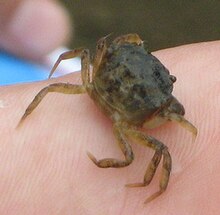Panopeidae: Difference between revisions
No edit summary Tags: Mobile edit Mobile web edit |
Tags: Mobile edit Mobile web edit |
||
| Line 22: | Line 22: | ||
==Ecology== |
==Ecology== |
||
The various genera of Panopeidae are morphologically similar, partly as a result of many instances of [[convergent evolution]] to similar habitats and food preferences.<ref name="Schubart"/> |
The various genera of the Panopeidae are morphologically similar, partly as a result of many instances of [[convergent evolution]] to similar habitats and food preferences.<ref name="Schubart"/> |
||
Crabs of the family Panopeidae are all free-living (not [[commensalism|commensal]] or [[parasitic]]),<ref name="ZCA"/> and typically live in soft-bottomed parts of the ocean,<ref name="Schubart">{{cite journal |author=C. D. Schubart, J. E. Neigel & D. L. Felder |year=2000 |title=Molecular phylogeny of mud crabs (Brachyura: Panopeidae) from the northwestern Atlantic and the role of morphological statis and convergence |journal=[[Marine Biology (journal)|Marine Biology]] |volume=137 |issue=1 |pages=11–18 |url=http://www.biologie.uni-regensburg.de/Zoologie/Heinze/Staff/ChristophSchubart/pdf/MarBiol-2000.pdf |format=[[Portable Document Format|PDF]] |doi=10.1007/s002270000325}}</ref> lending them the common name "mud crabs" (a name also shared by [[mud crab (disambiguation)|other organisms]]). They burrow into the sediment and feed on a variety of marine invertebrates.<ref name="Schubart"/> |
Crabs of the family Panopeidae are all free-living (not [[commensalism|commensal]] or [[parasitic]]),<ref name="ZCA"/> and typically live in soft-bottomed parts of the ocean,<ref name="Schubart">{{cite journal |author=C. D. Schubart, J. E. Neigel & D. L. Felder |year=2000 |title=Molecular phylogeny of mud crabs (Brachyura: Panopeidae) from the northwestern Atlantic and the role of morphological statis and convergence |journal=[[Marine Biology (journal)|Marine Biology]] |volume=137 |issue=1 |pages=11–18 |url=http://www.biologie.uni-regensburg.de/Zoologie/Heinze/Staff/ChristophSchubart/pdf/MarBiol-2000.pdf |format=[[Portable Document Format|PDF]] |doi=10.1007/s002270000325}}</ref> lending them the common name "mud crabs" (a name also shared by [[mud crab (disambiguation)|other organisms]]). They burrow into the sediment and feed on a variety of marine invertebrates.<ref name="Schubart"/> |
||
Revision as of 01:33, 5 April 2019
| Panopeidae | |
|---|---|

| |
| Dyspanopeus sayi | |
| Scientific classification | |
| Kingdom: | |
| Phylum: | |
| Subphylum: | |
| Class: | |
| Order: | |
| Infraorder: | |
| Superfamily: | |
| Family: | Panopeidae |
| Synonyms [2] | |
|
Eucratopsidae Stimpson, 1871 (nom. rej.) | |

The Panopeidae are a family containing 25 genera of morphologically similar crabs, often known as "mud crabs". Their centers of diversity are the Atlantic Ocean and eastern Pacific Ocean.
Distribution
Most members of the family Panopeidae live in the Atlantic Ocean or eastern Pacific Ocean. Only one species occurs in Australian waters – Homoioplax haswelli.[2]
Ecology
The various genera of the Panopeidae are morphologically similar, partly as a result of many instances of convergent evolution to similar habitats and food preferences.[3]
Crabs of the family Panopeidae are all free-living (not commensal or parasitic),[2] and typically live in soft-bottomed parts of the ocean,[3] lending them the common name "mud crabs" (a name also shared by other organisms). They burrow into the sediment and feed on a variety of marine invertebrates.[3]
Genera
The World Register of Marine Species lists the following subfamilies and genera:[1]
|
Eucratopsinae Stimpson, 1871
|
Panopeinae Ortmann, 1893
|
References
- ^ a b Davie, P. (2015). "Panopeidae Ortmann, 1893". WoRMS. World Register of Marine Species. Retrieved 2015-07-03.
- ^ a b c P. J. F. Davie (2002). "Panopeidae". Crustacea: Malocostraca: Eucarida (Part 2), Decapoda: Anomura, Brachyura. Zoological Catalogue of Australia. Vol. 19. Canberra, Australia: CSIRO Publishing. pp. 372–374. ISBN 978-0-643-06792-9.
- ^ a b c C. D. Schubart, J. E. Neigel & D. L. Felder (2000). "Molecular phylogeny of mud crabs (Brachyura: Panopeidae) from the northwestern Atlantic and the role of morphological statis and convergence" (PDF). Marine Biology. 137 (1): 11–18. doi:10.1007/s002270000325.
